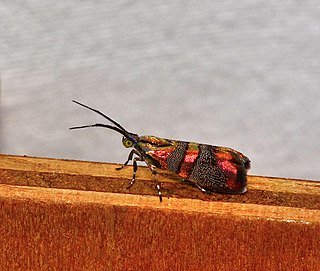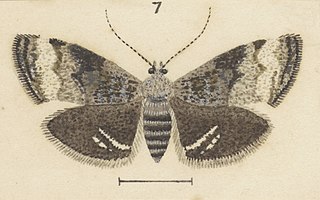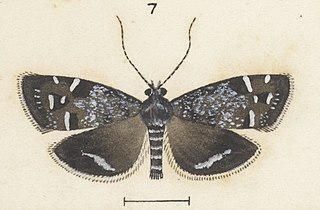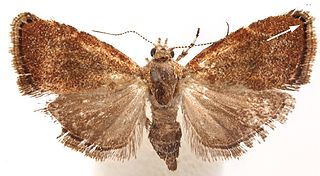
Ficus is a genus of about 850 species of woody trees, shrubs, vines, epiphytes and hemiepiphytes in the family Moraceae. Collectively known as fig trees or figs, they are native throughout the tropics with a few species extending into the semi-warm temperate zone. The common fig (F. carica) is a temperate species native to southwest Asia and the Mediterranean region, which has been widely cultivated from ancient times for its fruit, also referred to as figs. The fruit of most other species are also edible though they are usually of only local economic importance or eaten as bushfood. However, they are extremely important food resources for wildlife. Figs are also of considerable cultural importance throughout the tropics, both as objects of worship and for their many practical uses.

Choreutidae, or metalmark moths, are a family of insects in the lepidopteran order whose relationships have been long disputed. It was placed previously in the superfamily Yponomeutoidea in family Glyphipterigidae and in superfamily Sesioidea. It is now considered to represent its own superfamily. The relationship of the family to the other lineages in the group "Apoditrysia" need a new assessment, especially with new molecular data.
Kone is a Finnish elevator engineering and service company, founded in 1910. Kone, KONE, Koné and variants may also refer to:

Anthophila fabriciana, also known as the common nettle-tap, is a moth of the family Choreutidae first described in 1767 by Carl Linnaeus. The moth can be found flying around stinging nettles during the day.
Asterivora homotypa is a species of moth of the family Choreutidae. It is found in subalpine and alpine habitats in Australia. Adult moths have brown forewings, each with various white markings including two vague transverse white speckled bars. Their hindwings are brown, each with a vague white wiggly submarginal line. Their wingspan length is approximately 1 centimetre.
Choreutis sycopola is a species of moth of the family Choreutidae. It is found from southern Queensland to central New South Wales.

Glyphodes bivitralis is a moth of the family Crambidae described by Achille Guenée in 1854. It is native to south-east Asia, including Hong Kong, India, Japan, Taiwan and Thailand. It is also found in Queensland, Hawaii and Maldives.

Tortyra slossonia, commonly known as the reflective tortyra moth, ficus budworm or Slosson's metalmark moth, is a moth of the family Choreutidae. It is known from Florida.
Tortyra fulgens is a moth of the family Choreutidae. It was described by Cajetan Felder, Rudolf Felder and Alois Friedrich Rogenhofer in 1875 and is known from Colombia, Brazil and Bolivia.

Tebenna gnaphaliella, the everlasting tebenna moth, is a moth of the family Choreutidae. It is found from Florida to California and north at least to New Hampshire.
Choreutis achyrodes is a moth of the family Choreutidae. It is known from China, Japan, India (Assam) and the Oriental region.

Asterivora albifasciata is a species of moth in the family Choreutidae. It is endemic to New Zealand and has been observed on both the North and South Islands. The adults of this species are on the wing in December and January. Larvae of this species have been raised on Celmisia brevifolia.

Asterivora microlitha is a species of moth in the family Choreutidae. It is endemic to New Zealand.
Choreutis aegyptiaca is a species of moth of the family Choreutidae. It is found in the India, Nepal, Israel, Saudi Arabia, the United Arab Emirates, Yemen, Egypt, La Réunion, Nepal, Oman, Uganda, Namibia and South Africa.

Niveas is a genus of moths in the family Choreutidae.

Niveas agassizi is a moth of the family Choreutidae. It is found in Kenya.
Choreutis japonica is a moth in the family Choreutidae. It was described by Zeller in 1877. It is found in Japan.
Hemerophila diva, the Diva Hemerophila moth, is a moth in the family Choreutidae. It was described by Riley in 1889. It is found in Florida and Cuba.
Ornarantia dyari is a moth in the family Choreutidae. It was described by August Busck in 1900. It is found in Florida and on the Bahamas. The species name honors entomologist Harrison Gray Dyar Jr.
A tree in the Moraceae family, Ficus phaeosyce grows in eastern New Guinea, endemic to the nation of Papua Niugini. It is a shade tolerant understorey species, locally very abundant. A range of insect herbivores feed on the plant.










